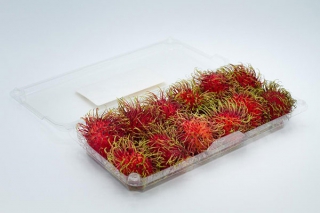
Rambutan: Exotic Fruit Perfect for Applications with a Tropical Flare
06 September 2018Rambutan is a juicy sweet fruit from Southeast Asia that looks like a sea urchin but tastes sweeter than grapes.
By Lisa Parrish, GMC Editor
Is it a hairy grape or spikey balls from a sweet gum tree? Not even close. Rambutan is an exotic tropical fruit hailing from Malay countries such as Malaysia and Indonesia. And, it’s just beginning to enter markets around the United States.
Similar to the lychee and longan, other popular fruits from the region, rambutan is sweet and juicy and somewhat reminiscent of an oversized peeled grape. The fruit’s name is derived from its red sea urchin-like outer skin. The word ramb is Malay for hairy. Inside is a large nutty seed wrapped in an edible white pulp. Rambutan can be peeled by using both hands and by twisting apart the outer layers at the seam or cutting lengthwise. Then, either remove the top peel and eat around the pit or pop the fruit out and cut the flesh off the pit.
Rambutan is very sweet but comes in at only 10 calories for each fruit. It is also high in fiber, iron and vitamin C.
HLB Specialties, the Florida-based importer of rambutan, expects it to be available in over 2,500 stores nationwide this year. “A few years ago, you would only see rambutans in Asian markets, and now they have really gained a big following,” notes Melissa Hartmann de Barros, HLB Specialties’ communications director. “I think it’s especially due to the fantastic taste and affordability.”
Originally from Southeast Asia, rambutan also grows in Guatemala and Honduras, where HLB Specialties sources them.
Rambutan can be eaten raw, added to a chartrudery board, included in curries for flavor complexity, or used in applications requiring a hint of tropical sweetness. Other culinary applications include traditional desserts like gelatos and puddings or complex soups.
